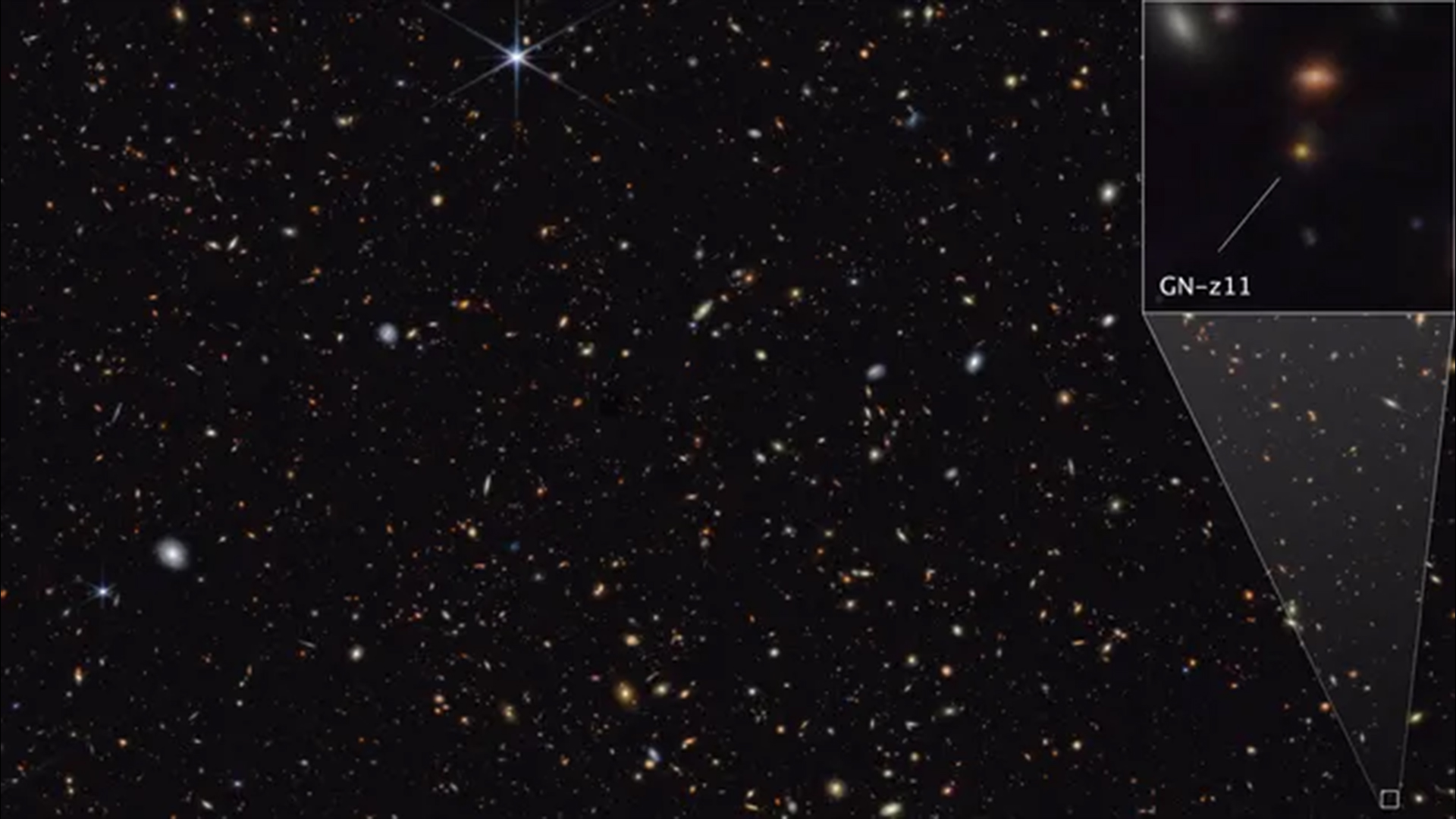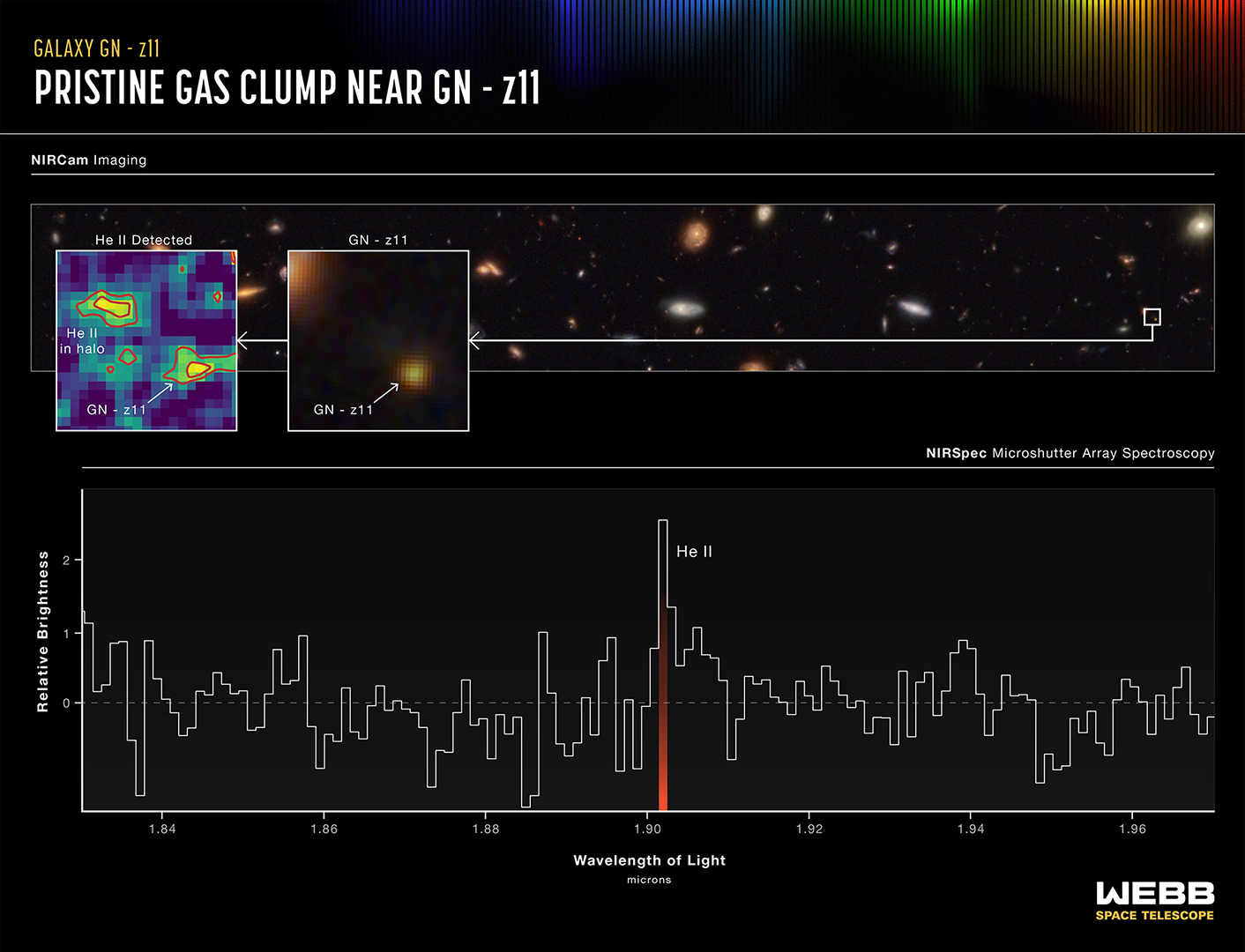The James Webb telescope may have found some of the very 1st stars in the universe
The James Webb Space Telescope zoomed in on galaxy GN-z11, which existed just 430 million years after the Big Bang, to reveal what may be some of the oldest stars in the universe.

Evidence for the first generation of stars to exist in the universe has come to light, thanks to observations made by the James Webb Space Telescope (JWST). The proof is located in one of the most distant galaxies known.
The galaxy, designated GN-z11, was discovered by the Hubble Space Telescope in 2015 and, prior to the launch of the James Webb Space Telescope, it was considered the most faraway galaxy known. With a redshift of 10.6, it makes more sense to talk about how long ago it existed, rather than how far away it is. That's because we see GN-z11 as it was just 430 million years after the Big Bang due to the time it took for its light to travel to our corner of the cosmos. For comparison, the universe today is 13.8 billion years old.
As such, GN-z11 was a prime target for the JWST to study. Now, two new papers describe profound discoveries about GN-z11 that reveal vital details about how galaxies that existed in the early universe were able to grow.
GN-z11 is the most luminous galaxy known at this particular redshift, and indeed this has become a common theme for high redshift galaxies now almost regularly being found in the early universe by the JWST. Many of them appear much brighter than what our models of galaxy formation predict they should be. Those predictions are based on the standard model of cosmology.
Now, the JWST's new observations seem to have shed light on what is going on.
An astronomy team, led by Roberto Maiolino of the University of Cambridge, has probed GN-z11 with the JWST's two near-infrared instruments, the Near-Infrared Camera (NIRCam) and the Near-Infrared Spectrometer (NIRSpec). The researchers discovered evidence for the first generation of stars, called Population III stars, as well as for a supermassive black hole gobbling up huge amounts of matter and growing at a vastly accelerated rate.
Get the world’s most fascinating discoveries delivered straight to your inbox.
Scientists can calculate the age of a star based on its abundance of heavy elements, which would have been formed by previous generations of stars that lived and died, spewing those heavy elements into space where they ultimately get recycled in star-forming regions to form new stellar bodies. The youngest stars that have formed during the past five or six billion years are referred to as Population I stars, and have the highest abundance of heavy elements. Our sun is a Population I star. Older stars contain fewer heavy elements because there had been fewer generations of stars before them. We call these Population II stars, and they live in the oldest regions of our Milky Way galaxy.
Population III stars, however, have been purely hypothetical up until now.
These would have been the first stars to form, and because no other stars came before them, they would have contained no heavy elements and be made from only the pristine hydrogen and helium forged during the Big Bang. These first stars are also thought to have been extremely luminous, with masses equal to at least several hundred suns.
Although astronomers still haven't seen Population III stars directly, Maiolino's team detected indirect evidence for them in GN-z11. NIRSpec observed a clump of ionized helium near the edge of GN-z11.
"The fact that we don't see anything else beyond helium suggests that this clump must be fairly pristine," said Maiolino in a statement. "This is something that was expected by theory and simulations in the vicinity of particularly massive galaxies from these epochs — that there should be pockets of pristine gas surviving in the halo, and these may collapse and form Population III stars."
This helium gas is being ionized by something that's producing huge amounts of ultraviolet light, with that something inferred as the Population III stars. Potentially, the helium witnessed is leftover material from those stars' formation. The amount of ultraviolet light required to ionize all that gas requires about 600,000 solar masses of stars in total, shining with a combined luminosity 20 trillion times brighter than our sun. These figures suggest distant galaxies such as GN-z11 would've been more adept at forming massive stars than galaxies in the modern universe.
Meanwhile, according to a second set of results, Maiolino's team also found evidence for a two-million-solar-mass black hole at the heart of GN-z11.
The team also detected a powerful sleet of radiation flowing off the accretion disk of matter swirling around the black hole as well as ionized chemical elements typically found near accreting black holes. It is the most distant supermassive black hole discovered so far, the team says, and its gluttonous appetite leads to its accretion disk becoming dense and hot, and shining brightly. This, combined with the Population III stars, is what makes GN-z11 shine so brightly, the researchers believe, without breaking standard cosmology as some have prematurely claimed.
The study on the ionized helium clump and Population III stars has been accepted for publication in the journal Astronomy & Astrophysics, and a preprint can be found here. Meanwhile, the study on NIRCam observations of the black hole were published on 17 January in the journal Nature.
Originally posted on Space.com.




